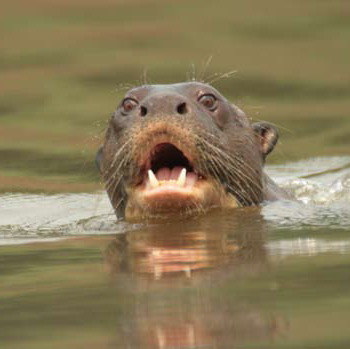Guyana bans gold mining in the 'Land of the Giants'
Guyana has banned gold dredging in the Rewa Head region after an expedition turned up unspoiled wilderness and mind-boggling biodiversity. The researchers, in just six weeks, stumbled on the world's largest snake (anaconda), spider (the aptly named goliath bird-eating spider), armadillo (the giant armadillo), anteater (the giant anteater), and otter (the giant otter), leading them to dub the area 'the Land of the Giants'
Jeremy Hance | mongabay.com | March 01, 2010
"During our brief survey we had encounters with wildlife that tropical biologists can spend years in the field waiting for. On a single day we had two tapirs paddle alongside our boat, we were swooped on by a crested eagle and then later charged by a group of giant otters. I think that about sums the place up. There is little human disturbance in the Rewa Head and as a result, wildlife flourishes in blissful naivety," one of the expedition members, Rob Pickles, said in a press release.
The photo shows an "inquisitive adult male giant otter approaching the boat. While some individuals are remarkably fearless and will approach to within several yards of the boat, the mood of the group is determined by the breeding female. If she feels threatened the group will normally 'periscope' and disappear," according to Biodiversity Report on Rewa Head. Photo by Robert Pickles.
Pickles, a PhD student studying giant river otters, teamed up with another PhD student, tapir-expert Niall McCann, to explore the area with the aid of the Zoological Society of London (ZSL). Astonishingly the team encountered six anacondas during their expedition, four of which were over 16 feet long.
But it wasn't just big species that the team recorded, but rare ones as well. Pickles and McCann recorded the presence of half of Guyana's listed threatened species during their expedition, including crested and harpy eagles, as well as the little-seen bush dog.
"Visiting the Rewa Head felt like we were walking in the footsteps of Wallace and Bates, seeing South America with its natural density of wild animals as it would have appeared 150 years ago," Pickles told mongabay.com in a recent interview regarding their expedition.
Despite the good news that Guyana has banned gold mining in the area, the Rewa Head remains threatened.
"[The area] currently lies in a logging concession. Unless Guyana is given alternative financial incentives, its government will be forced to lease its land to oil drillers, miners and loggers. One of the world’s last Edens is on the brink of destruction," explains Niall McCann.
Currently, the US-owned company, Simon and Shock International, has a license to extract timber from 400,000 hectares, while oil drilling concessions cover 78 million hectares.
McCann and Pickles are working with ZSL conservationists to gain international support for the government of Guyana's plan to conserve its vast forests as a carbon sink for financial returns. According to the conservationists, the area is a perfect testing ground for projects like REDD+ (Reducing Emissions through Deforestation and Forest Degradation).
"Guyana is in an incredibly fortunate position in that it still retains 76 percent of its forest cover which constitutes some of the most carbon-rich forests of South America. As such, and with a president keen to offer his nation’s forests as part of the world’s carbon sink, Guyana should be embraced by the international community," Pickles told mongabay.com in the interview.
In all Pickles and McCann recorded 251 bird species and 33 large mammal species in Rewa Head.
"In the wake of Copenhagen and the build up to the Convention on Biological Diversity, reducing biodiversity loss and greenhouse gas emissions are high on the political agenda. Protecting areas such as the Rewa Head through sustainable management is a positive strategy for addressing these key issues," said Professor Jonathan Baillie, Director of Conservation at ZSL, adding that "global leaders need to recognize that real economic benefits are to be gained through the conservation, not destruction, of our world’s living things."
To read the interview with Robert Pickles: Guyana expedition finds biodiversity trove in area slated for oil and gas development, an interview with Robert Pickles
Anaconda found in Rewa Head. Photo by Ashley Holland.
The jaguar Panthera onca is classified as Near Threatened: a previous six-week expedition to Rewa Head observed ten jaguars. Photo by: Ashley Holland and Gordon Duncan.
World's largest spider, the goliath bird-eating spider Theraphosa blondii, from Guyana’s interior. Photo by: Gordon Duncan.
According to biodiversity report: "In the dry season huge sandy beaches are exposed in the Lower Rewa, providing a nesting ground for giant South American river turtles (Podocnemis expansa). The superabundance of eggs laid in these sand banks is a boon which many forest species time their breeding cycle to coincide with." Photo by Ashley Holland.
Brazilian tapir Tapirus terrestrisi photographed 10ft from the expedition boat. The Brazilian tapir is classified as Vulnerable. Photo by: Robert Pickles.
Schneider’s dwarf caiman Paleosuchus trigonatus. Photo by: Niall McCann.
"Hand-axe sharpening grooves and geometric designs below Corona Falls on the River Rewa testify to the fact that there were once indigenous people inhabiting this area," according to Biodiversity report. Photo by: Rob Pickles.
Copyright mongabay 2010 Read more... Sphere: Related Content
Logging and oil concession in Rewa Head. Map courtesy of Mike Robert Pickles.











No comments:
Post a Comment